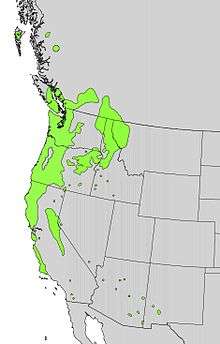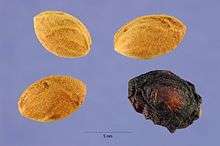Prunus emarginata
Prunus emarginata, the bitter cherry[2] or Oregon cherry, is a species of Prunus native to western North America, from British Columbia south to Baja California, and east as far as western Wyoming and New Mexico.[3][4] It is often found in recently disturbed areas or open woods on nutrient-rich soil.[5][6][7]
| Prunus emarginata | |
|---|---|
| Prunus emarginata leaves and flowers | |
| Scientific classification | |
| Kingdom: | Plantae |
| Clade: | Tracheophytes |
| Clade: | Angiosperms |
| Clade: | Eudicots |
| Clade: | Rosids |
| Order: | Rosales |
| Family: | Rosaceae |
| Genus: | Prunus |
| Subgenus: | Prunus subg. Cerasus |
| Species: | P. emarginata |
| Binomial name | |
| Prunus emarginata | |
 | |
| Natural range | |
| Synonyms[1] | |
| |
Description

Prunus emarginata is a deciduous shrub or small tree growing to 1–15 metres (3.3–49.2 ft) tall with a slender oval trunk with smooth gray to reddish-brown bark with horizontal lenticels. The leaves are 2–8 centimetres (0.79–3.15 in) long, thin, egg-shaped, and yellowish-green with unevenly sized teeth on either side. The flowers are small, 10–15 millimetres (0.39–0.59 in) diameter, with five white petals and numerous hairlike stamens; they are almond-scented, and produced in clusters in spring, and are pollinated by insects. The fruit is a juicy red or purple cherry 7–14 millimetres (0.28–0.55 in) diameter, which, as the plant's English name suggests, are bitter. As well as reproducing by seed, it also sends out underground stems which then sprout above the surface to create a thicket.[6][7][8]
There are two varieties:[6][2]
- Prunus emarginata var. emarginata. Usually shrubby; young shoots and leaves hairless or only thinly hairy. Most of the species' range.
- Prunus emarginata var. mollis (Dougl.) Brew. A larger tree; young shoots and leaves downy. Oregon north to British Columbia, mainly coastal.
Cultivation
It has hybridized with the introduced European Prunus avium in the Puget Sound area; the hybrid has been named Prunus × pugetensis. It is intermediate between the parent species, but is nearly sterile, producing almost no cherries.[9]
Uses
The bitter cherries are not edible by humans. However, they are eaten by some birds (especially cedar waxwing)[10] and mammals, and deer and livestock forage on the leaves.[11]
Medicinal
Native tribes, most notably Kwakwaka'wakw, used other parts of the plant for medicinal purposes, such as poultices and bark infusions.[12] The isoflavone prunetin was isolated for the first time by Finnemore in 1910 from the bark of P. emarginata.[13]
Ecology
It is a larval host to the blinded sphinx, elegant sphinx, Lorquin's admiral, pale tiger swallowtail, small-eyed sphinx, spring azure, twin-spotted sphinx, and western tiger swallowtail.[14]

References
- The Plant List, Prunus emarginata (Douglas ex Hook.) Walp.
- "Prunus emarginata". Natural Resources Conservation Service PLANTS Database. USDA. Retrieved 14 October 2015.
- Biota of North America Program 2014 county distribution map
- SEINet, Southwestern Biodiversity, Arizona chapter photos, description, distribution map
- "Prunus emarginata". Germplasm Resources Information Network (GRIN). Agricultural Research Service (ARS), United States Department of Agriculture (USDA). Retrieved 26 December 2017.
- Plants of British Columbia: Prunus emarginata
- Jepson Flora: Prunus emarginata
- Flora of North America, Prunus emarginata (Douglas) Eaton, Man. Bot. ed. 7. 463. 1836. Bitter cherry
- Jacobson, A. L. & Zika, P. F. (2007). A new hybrid cherry, Prunus × pugetensis (P. avium × emarginata, Rosaceae), from the Pacific Northwest. Madroño 54: 74–85. Abstract
- Peattie, Donald Culross (1953). A Natural History of Western Trees. New York: Bonanza Books. p. 538.
- Little, Elbert L. (1994) [1980]. The Audubon Society Field Guide to North American Trees: Western Region (Chanticleer Press ed.). Knopf. p. 467. ISBN 0394507614.
- Casebeer, M. (2004). Discover California Shrubs. Sonora, California: Hooker Press. ISBN 0-9665463-1-8
- Isoflavones. III. The structure of prunetin and a new synthesis of genistein. R. L. Shriner, C. J. Hull, J. Org. Chem., 1945, 10 (4), pp 288–291
- The Xerces Society (2016), Gardening for Butterflies: How You Can Attract and Protect Beautiful, Beneficial Insects, Timber Press.
External links
| Wikimedia Commons has media related to Prunus emarginata. |